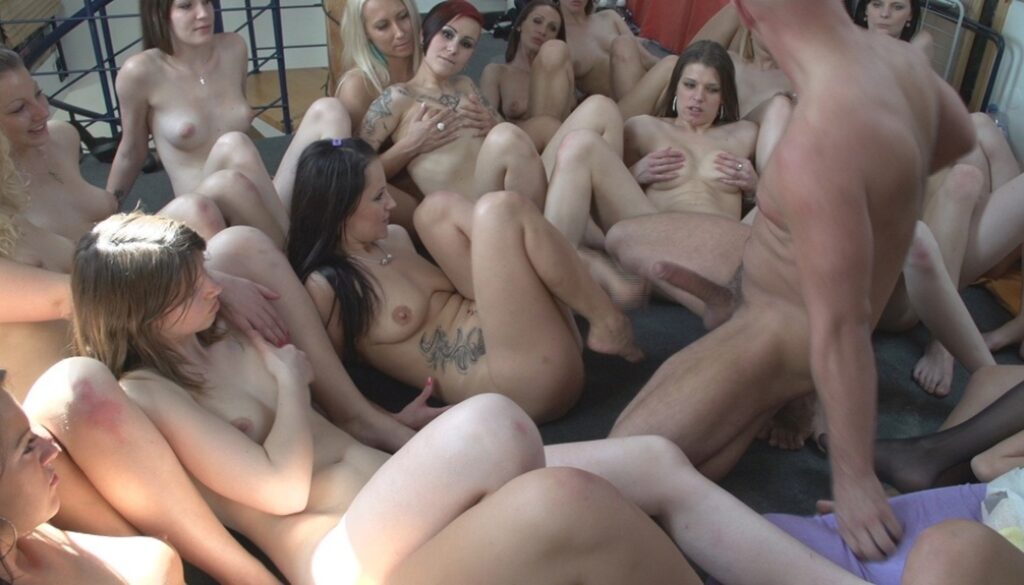Orgy, Unmasked: How Group Pleasure Became a Social Ritual (and Why It Still Hits So Hard)
Picture a living room you actually recognize – nothing staged, no velvet ropes, no movie set nonsense. Music low, lights warm, people who look like they came from a dinner party, not a casting call. Someone laughs too loud, someone’s flirting at the snack table, a pair slips down the hallway and returns with hair just a little wrecked. This isn’t fantasy with smoke machines; it’s human weather. That’s what makes the lore of the orgy so sticky in our culture: it’s spectacle, yes, but it’s also community. If you want to see the fantasy distilled and unapologetic, the catalog at ModPorn Orgy shows how the idea evolved from eyebrow-raising rumor to a polished, many-hands art form – the big-room energy, the neural fireworks, and the micro-moments you only get when desire stops being a two-person sport.
Here’s the honest bit people don’t say out loud: the orgy archetype is frightening and enticing for the same reason. Too much attention, too many choices, too little script. And yet that “too much” is the fuel. You’re not stuck in one loop, one position, one friction track; you’re sharing a current with a room. The brain reads it as novelty and chorus at once. And if your curiosity has ever spun at 2 a.m., you probably, all night long, scrolled through videos or stories trying to decode what makes a great group scene feel less like chaos and more like a dance. Turns out, it’s not only sex. It’s architecture, etiquette, and a weirdly wholesome streak of hospitality.
What an Orgy Actually Is (and What It Isn’t)
Let’s clear one myth fast: an orgy isn’t a single template. It’s a spectrum – from soft-swap house hangs where kissing and massage are the main act, to full-tilt pile-ups that look like liquids and limbs forgot where to stop. Sometimes it’s masked and theatrical; sometimes it’s pajama-casual with a charcuterie board that becomes unintentionally symbolic when someone grabs the honey. Some groups love structure (colored wristbands for “touch/no touch,” “watch only,” “open to couples”), others just set a few bright-line rules and let the night breathe. Either way, the common denominator isn’t the number of people. It’s shared consent and a shared frame: tonight, this is our sandbox.
The big secret: the best rooms run on slow. Not puritan slow – attuned slow. Before anything serious happens, there’s usually a period where the social temperature gets checked. Is everyone fed? Hydrated? Phones away? Is the host grounding the room? Are pronouns and boundaries stated simply, cleanly, without a TED Talk? That quiet scaffolding makes spontaneity possible later. You notice the rooms that skip it. Those parties fizzle, or they sprint and collapse. A good orgy is more like jazz: a key gets established, the rhythm section is tight, and then solos explode without scaring the band.
Watching curated group scenes online can be a helpful mirror for real-life pacing. Yes, it’s edited. But notice the beats great creators preserve: a glance that checks in before a hand moves; someone guiding another person’s wrist; a smile that says “stay” without words. Even in polished titles, you can spot micro-consent in action. That’s the scaffolding. Without it, all you have is noise. With it, the chorus starts to tune.
And because someone will ask: jealousy isn’t a glitch; it’s data. People think group contexts require the absence of insecure feelings. Wrong. All that’s required is literacy. If a pang hits, the fix isn’t to bulldoze it; it’s to name it and re-route. In a good room, you’ll see that happen without drama: a partner squeezes a hand and swaps into “watch” mode, or moves closer to witness instead of compete. The energy doesn’t drop; it redistributes. That’s one of the quieter skills seasoned groups practice – how to re-arrange without shaming the feeling.
If this all sounds strangely… considerate, that’s because it is. Orgies that last more than a single chaotic event do so because the people running them have figured out that hospitality and heat aren’t enemies. In the same way a great dinner party lives or dies on seating and lighting, a great group night depends on flow, light, sound, tactile cues, and the soft choreography of “where do hands go next.” It’s erotic city planning.
The Mechanics: Flow, Roles, and the Consent That Makes It Work
Think choreography, not checklists. Rooms work better when there are roles people can slip in and out of without permission slips. A “welcomer” who keeps an eye on new arrivals; a “tender” who remembers water and towels; a “DJ” who knows when to let the playlist quiet down so breath and skin become the soundtrack; a “watch angel” who hangs at the edges and notices tension before it spikes. None of these are formal titles; they’re behaviors people adopt when they care about the mood as much as the motion. And yes, when you watch sharp group content online, you can often spot these role shifts even in edited form – someone breaks from the heat to adjust a pillow, another person checks the lube or dims a lamp. Those are not accidents; they’re micro-acts of hosting that keep a crowd scene human.
Flow is also about zones, not just bodies. The best rooms aren’t one bed and a hope. They’re zones: a soft area where pace stays slow; a high-energy corner for the clamor kids; a threshold where watchers can perch without being dragged in; a kitchen reset with snacks and neutral chatter. Movement between zones is eligible consent. Someone who slides from the couch to the rug just opted into a different energy. Someone who drifts back to the kitchen opted out for now. It’s visible and legible, and it lets newcomers feel the dial, not just the volume.
Consent scripts don’t have to be corporate. People fear that pausing for words will kill the mood; in practice, it lubricates it. “Good here?” “Want more?” “Stay?” Those three tiny prompts can carry an entire night. The trick is making it a dialect the room shares. If half the room runs on silent reads and half runs on verbal checks, you get cross-talk. Pick a simple norm. Some rooms snap fingers twice for “more,” tap once for “ease,” and hold a palm for “stop.” Corny? Maybe. Effective? Absurdly.
The other mechanical piece nobody warns you about: attention. Orgies are attention economies. They reward the people who listen with their hands. You can spot a rookie by the way they grab for center stage. You can spot an artist by the way they amplify someone else’s moment, then melt away. Great group clips online show this principle as composition: not every frame has to be maximal; a tight shot on a hand guiding a hip can be hotter than a full-room tangle. In person, the analog is eye contact – the kind that says “I see you getting lit up, keep going.” That’s the crowd version of foreplay.
Hygiene and care are not side quests. There’s the obvious stuff – fresh towels, condoms in arm’s reach, gloves for those who prefer, trash within a step, a lube that won’t stain. Then there’s meta-care: room temperature, breaks, letting people return to neutral with a blanket or just laughter. Aftercare isn’t only for heavy scenes; it’s for any scene where nervous systems cranked up high. A pile of humans who just shared breath will need a descent. Music shifts down, lights come up a notch, somebody starts a goofy conversation about the worst movie they’ve ever cried to. You’d be shocked how often the best memory from a night is the fifteen minutes after the big crescendo – the part where people sprawl, snack, and decompress like athletes who just ran the prettiest relay.
Risk and boundaries are part of the craft, not decorations. The high-functioning rooms set red lines early (no filming, no pressure, no substances for anyone who doesn’t want them, no “selling” a person to the room, no shaming a “not tonight”). Those lines let everything inside the box feel safer. Online, platforms that are serious about group content show that ethic in tagging and pacing — you’ll see “negotiation” moments left in, safety supplies visible, cuts that preserve the check-ins instead of chopping them out. That’s not PR. That’s instruction by example.
If you’re nerdy about the mind science: part of why crowds are so potent is that arousal is contagious. Humans sync – breath, micro-motions, heart rate. Group contexts make that visible. Your body learns a new trick: to be turned on by other people’s turn-on without needing to own the center. Some folks report the weirdest, sweetest shift of all – they come to watch as much as to be watched, because watching stops being passive. It becomes participation, like singing harmony in the back row of a choir and hearing the chord bloom.
Etiquette, Myths, and the Long Tail of the Orgy Imagination
Etiquette is a love language. You can’t fake it. “Ask before you touch” is the tablet; “read the scene” is the practice. Bring what you wish existed if you were shy: extra robe, hair ties, snacks that aren’t sex props (grapes melt into comedy way too fast), sparkling water that replaces the glass someone dropped with their jaw. Don’t hoard, don’t direct traffic unless something’s off, don’t treat anyone like a trophy. And yes, say people’s names. Or their chosen names. “You good, Sky?” is hotter than silence because it respects the human inside the heat.
Myths die hard. No, you don’t have to be a gymnast. No, everyone won’t stare if you take a breather. No, it’s not a permanent relationship verdict if you and your partner try and don’t love it. The orgy imagination has been colonized by frat-house parody and glossy ads. The lived thing is more zany and more tender. Someone will laugh at the worst possible moment and it will make the room better. Someone’s knee will cramp. Someone will tell the story of the time they confused massage oil with chili oil and half the room will pause just to gasp. The point isn’t perfection. It’s play.
History puts orgies in togas and candlelit grottoes; the truth is they’ve always been neighborhood affairs wearing whatever the era’s normal clothes were. That familiarity is why the fantasy keeps returning – not because humanity is decadent, but because we’re pack animals who sometimes want our pleasure to be a campfire instead of a candle. The difference between a campfire and a wildfire is the ring of stones around it. Etiquette, consent, zones, roles – those are the stones. With them, a crowd scene is warm. Without them, it’s heat without a hearth.
Watching curated titles can be a classroom. The orchestration you see in well-made orgy content – people repositioning, the tempo changing, a lull that’s obviously intentional – is often closer to real-life best practice than the stereotypes. Browse with an eye for craft and you’ll start to notice the metadata: who checks in, who models “no,” who introduces aftercare, who treats the camera like another guest who needs to be welcomed, not conquered. The better studios and indie creators are teaching those skills without calling them skills. That’s a public service disguised as lust.
If you want a straight-world explainer on why people chase group scenarios, there are health and psych writers who cover it without moral panic. This Psychology Today overview doesn’t judge; it maps the motivations – novelty seeking, social validation, the relief of not having to be “everything” for one person in one night. You don’t have to agree to learn a lot about why the choir keeps calling.
Common sense gear list, no drama: water, lube (a kind that won’t wreck sheets), multiple condom sizes, gloves for whoever wants them, wipes, towels, a hamper or bag so the room doesn’t turn into laundry, a low table for supplies so nobody’s fishing on the floor. Light sources you can dim without turning the place into a dungeon – string lights, a shaded lamp, indirect LEDs. Music that can fall away. A fan or cracked window so the room doesn’t fog into a sauna unless that’s the vibe. And bathrooms with clean surfaces and trash that isn’t a horror show – you will be someone’s hero if you remember the small bin liners.
And the exit ritual? Underrated. A good host lands the plane: twenty minutes of gentle debrief, neutral talk, a last check for belongings, a group laugh, maybe a text the next day that says “Thanks for your trust.” The night lives longer because it closed well. Online, the analog is a final frame that doesn’t cut hard on climax but lets faces soften, hands squeeze, bodies flop into laughter. That’s the memory glue. That’s what brings people back.
In the end, “orgy” is a big word for a simple hunger: to feel desire as a social field, not a two-person tunnel. When it works, it’s not because people forgot their manners; it’s because they made new ones. When it stumbles, it’s not because group is doomed; it’s because the frame cracked. If you’re curious, be curious with craft. Watch the rooms that care. Learn their small moves. And if you’re just in it for the spectacle – fair. The spectacle can be gorgeous. Just remember what’s hiding under it: a handful of humans quietly taking care of each other so the roar can rise without breaking anything important.
If you want a straight-world explainer on why people chase group scenarios, there are health and psych writers who cover it without moral panic. This Psychology Today essay tracks the cultural history and psychology of orgies—how novelty, social permission, and role-reversal create a powerful mix—and does it in plain language without judgment. You don’t have to agree with every take to learn why the chorus keeps calling.




